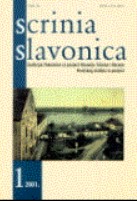PROMJENA BRODSKE GRADSKE UPRAVE 1942. GODINE – SUKOB STARE I NOVE ELITE?
THE CHANGE OF THE CITY GOVERNMENT IN 1942 – A CONFLICT BETWEEN AN OLD AND A NEW ELITE?
Author(s): Ivan MilecContributor(s): Mica Orban Kljajić (Translator)
Subject(s): Local History / Microhistory, Political history, Government/Political systems, Nationalism Studies, WW II and following years (1940 - 1949)
Published by: Hrvatski institut za povijest
Keywords: Brod on the Sava River; Slavonski Brod; Ustasha movement; local Ustasha elite; Slavko Vrgoč; Hrvatski radiša;
Summary/Abstract: On the basis of unpublished archival materials, publications of the time and relevant literature, this paper endeavours to reconstruct and analyse the process of the dismissal of Slavko Vrgoč, the mayor of Brod, as well as the appointment of a new city government. As there were no elections at any level, the city governments were dependent on the appointments of higher authorities. Although they were formally supposed to be formed on the basis of the arrangement of various actors (the county or Velika župa, the Ustasha movement, Croatian Labour Union), in reality they had to rely on informal relations and influences of individuals or groups. After the establishment of the new government in 1941, Vrgoč became the mayor of Brod and Ustasha quartermaster, and thus the considerable prerogatives of civil and Ustasha government branches were combined in one person. Even at that time several groups of the same ideological spectrum, which aspired to key positions, appeared; the reactions to the aforementioned conflicts became apparent later when some of the players turned out to be Vrgoč’s opponents. Vrgoč’s dismissal from the position of Ustasha quartermaster in Summer 1942 and from the mayorship in December of the same year, were the result of month-long political conflicts between a few stakeholders and individuals from various institutions or organizations that are an excellent example of the heterogeneity of the people from lower classes who actively or passively supported the NDH regime. Apart from the personal animosities of some of the players and the struggle for power, the aforementioned process showed the conflict between the new, Ustasha, elite in the process of being formed, with its tendency to grab power, and the parts of the new, pre-war, elite, which joined the new regime. Through the control of various institutions, its economic power and earlier networks endeavoured to secure its positions and increase its influence, primarily through the “nationalisation of the economy”. Exactly this struggle for expropriated Jewish possessions was one of the reasons for the conflict between Mayor Vrgoč and a group of influential economists from Brod united in the Hrvatski radiša organisation who formally administered the expropriated possessions. The conflict ended with the dismissal of the compromised Vrgoč and the appointment of Dr Josip Koprivčević, a lawyer and historian, as mayor; until his appointment, he had neither been engaged in politics nor had he been a member of the Ustasha movement. This paper is not only a contribution to the history of Slavonski Brod in the period of the NDH, but also provides corrections of certain inaccuracies and erroneous interpretations apparent in the current literature. In a wider context, this article discusses one aspect of the activities of the Ustasha regime and describes various political conflicts, power struggles as well as frequent usurpations and misuse within the regime on the local level.
Journal: Scrinia Slavonica
- Issue Year: 2021
- Issue No: 21
- Page Range: 389-430
- Page Count: 42
- Language: Croatian

